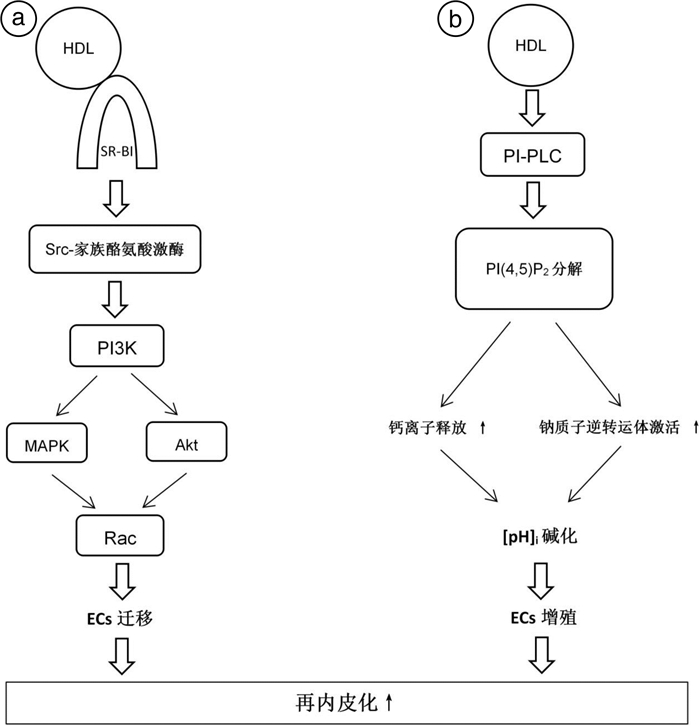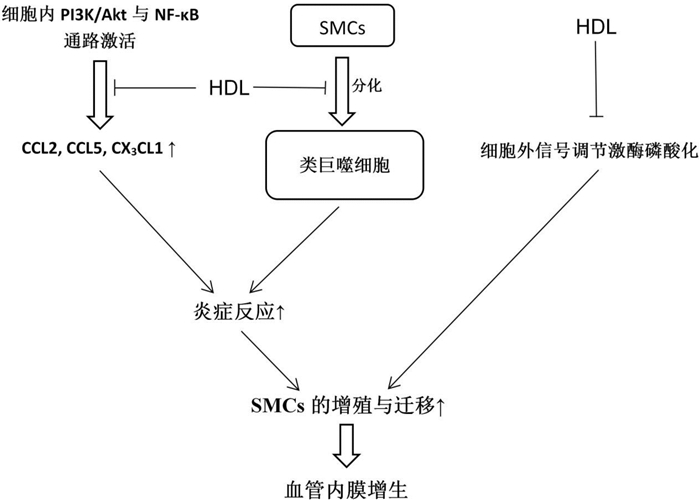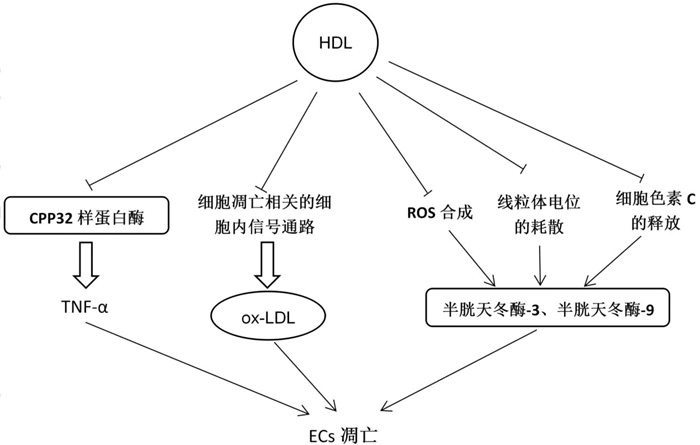Impact of HDL on stent biocompatibility and the potential value of HDL infusion therapy after PCI
-
摘要: 尽管介入技术与支架设计不断进步,但是支架生物相容性方面的问题仍然存在,包括支架内新生动脉粥样硬化和再内皮化延迟,这些问题会导致支架内再狭窄(ISR)和支架内血栓形成(ST)。高密度脂蛋白(HDL)是一种重要的抗动脉粥样硬化因子,对动脉粥样硬化性心血管疾病(ASCVD)的患者具有保护作用。它能够维护血管内皮正常功能、保护内皮完整性、促进再内皮化、抑制炎症反应和血小板活化,对改善经皮冠状动脉介入术(PCI)术后支架生物相容性有一定的作用。本文就HDL对ASCVD患者PCI术后支架生物相容性的影响进行综述,并探讨HDL输注治疗的新应用方向。Abstract: Even the interventional techniques and stent design continue to improve, unresolved problems about stent biocompatibility persist, including neoatherosclerosis and delayed re-endothelialization, which cause in-stent restenosis(ISR) and stent thrombosis(ST). High-density lipoprotein(HDL) is widely recognized as an essential anti-atherogenic factor that plays a protective role against atherosclerotic cardiovascular disease(ASCVD). It can maintenance of vascular endothelial function, protection of endothelial integrity, enhancement of re-endothelialization, reduction of inflammation and platelet activation, playing a certain role in improvement of stent biocompatibility after percutaneous coronary intervention(PCI). The article is to review the effect of HDL on stent biocompatibility in ASCVD patients following PCI and discuss a novel therapeutic direction of HDL infusion therapy.
-

-
[1] Wenaweser P, Daemen J, Zwahlen M, et al. Incidence and correlates of drug-eluting stent thrombosis in routine clinical practice. 4-year results from a large 2-institutional cohort study[J]. J Am Coll Cardiol, 2008, 52(14): 1134-1140. doi: 10.1016/j.jacc.2008.07.006
[2] Serruys PW, Onuma Y, Garg S, et al. 5-year clinical outcomes of the ARTS Ⅱ(Arterial Revascularization Therapies Study Ⅱ)of the sirolimus-eluting stent in the treatment of patients with multivessel de novo coronary artery lesions[J]. J Am Coll Cardiol, 2010, 55(11): 1093-1101. doi: 10.1016/j.jacc.2009.11.049
[3] Pfisterer ME. Late stent thrombosis after drug-eluting stent implantation for acute myocardial infarction: a new red flag is raised[J]. Circulation, 2008, 118(11): 1117-1119. doi: 10.1161/CIRCULATIONAHA.108.803627
[4] Chen N, Frishman WH. High-Density Lipoprotein Infusion Therapy and Atherosclerosis: Current Research and Future Directions[J]. Cardiol Rev, 2016, 24(6): 298-302. doi: 10.1097/CRD.0000000000000111
[5] Santos-Gallego CG, Badimon JJ, Rosenson RS. Beginning to understand high-density lipoproteins[J]. Endocrinol Metab Clin North Am, 2014, 43(4): 913-947. doi: 10.1016/j.ecl.2014.08.001
[6] Catapano A L, Graham I, De Backer G, et al. 2016 ESC/EAS Guidelines for the Management of Dyslipidaemias[J]. Eur Heart J, 2016, 37(39): 2999-3058. doi: 10.1093/eurheartj/ehw272
[7] Byrne RA, Joner M, Kastrati A. Stent thrombosis and restenosis: what have we learned and where are we going? The Andreas Gruntzig Lecture ESC 2014[J]. Eur Heart J, 2015, 36(47): 3320-3331. doi: 10.1093/eurheartj/ehv511
[8] Li XP, Zhao SP, Zhang XY, et al. Protective effect of high density lipoprotein on endothelium-dependent vasodilatation[J]. Int J Cardiol, 2000, 73(3): 231-236. doi: 10.1016/S0167-5273(00)00221-7
[9] Matsuda Y, Hirata K, Inoue N, et al. High density lipoprotein reverses inhibitory effect of oxidized low density lipoprotein on endothelium-dependent arterial relaxation[J]. Circ Res, 1993, 72(5): 1103-1109. doi: 10.1161/01.RES.72.5.1103
[10] Zeiher AM, Schächlinger V, Hohnloser SH, et al. Coronary atherosclerotic wall thickening and vascular reactivity in humans. Elevated high-density lipoprotein levels ameliorate abnormal vasoconstriction in early atherosclerosis[J]. Circulation, 1994, 89(6): 2525-32. doi: 10.1161/01.CIR.89.6.2525
[11] Terasaka N, Yu S, Yvan-Charvet L, et al. ABCG1 and HDL protect against endothelial dysfunction in mice fed a high-cholesterol diet[J]. J Clin Invest, 2008, 118(11): 3701-3713. doi: 10.1172/JCI35470
[12] Witting PK, Song C, Hsu K, et al. The acute-phase protein serum amyloid A induces endothelial dysfunction that is inhibited by high-density lipoprotein[J]. Free Radic Biol Med, 2011, 51(7): 1390-1398. doi: 10.1016/j.freeradbiomed.2011.06.031
[13] Nieuwdorp M, Vergeer M, Bisoendial RJ, et al. Reconstituted HDL infusion restores endothelial function in patients with type 2 diabetes mellitus[J]. Diabetologia, 2008, 51(6): 1081-1084. doi: 10.1007/s00125-008-0975-2
[14] Viñals M, Martínez-González J, Badimon JJ, et al. HDL-induced prostacyclin release in smooth muscle cells is dependent on cyclooxygenase-2(Cox-2)[J]. Arterioscler Thromb Vasc Biol, 1997, 17(12): 3481-3488. doi: 10.1161/01.ATV.17.12.3481
[15] Seetharam D, Mineo C, Gormley AK, et al. High-density lipoprotein promotes endothelial cell migration and reendothelialization via scavenger receptor-B type Ⅰ[J]. Circ Res, 2006, 98(1): 63-72. doi: 10.1161/01.RES.0000199272.59432.5b
[16] Tamagaki T, Sawada S, Imamura H, et al. Effects of high-density lipoproteins on intracellular pH and proliferation of human vascular endothelial cells[J]. Atherosclerosis, 1996, 123(1-2): 73-82. doi: 10.1016/0021-9150(95)05774-9
[17] Vanags LZ, Tan J, Galougahi KK, et al. Apolipoprotein A-Ⅰ Reduces In-Stent Restenosis and Platelet Activation and Alters Neointimal Cellular Phenotype[J]. JACC Basic Transl Sci, 2018, 3(2): 200-209. doi: 10.1016/j.jacbts.2017.11.006
[18] van der Vorst EP, Vanags LZ, Dunn LL, et al. High-density lipoproteins suppress chemokine expression and proliferation in human vascular smooth muscle cells[J]. FASEB J, 2013, 27(4): 1413-1425. doi: 10.1096/fj.12-212753
[19] Rong JX, Shapiro M, Trogan E, et al. Transdifferentiation of mouse aortic smooth muscle cells to a macrophage-like state after cholesterol loading[J]. Proc Natl Acad Sci U S A, 2003, 100(23): 13531-13536. doi: 10.1073/pnas.1735526100
[20] Sugano M, Tsuchida K, Makino N. High-density lipoproteins protect endothelial cells from tumor necrosis factor-alpha-induced apoptosis[J]. Biochem Biophys Res Commun, 2000, 272(3): 872-876. doi: 10.1006/bbrc.2000.2877
[21] Suc I, Escargueil-Blanc I, Troly M, et al. HDL and ApoA prevent cell death of endothelial cells induced by oxidized LDL[J]. Arterioscler Thromb Vasc Biol, 1997, 17(10): 2158-2166. doi: 10.1161/01.ATV.17.10.2158
[22] de Souza JA, Vindis C, Nègre-Salvayre A, et al. Small, dense HDL 3 particles attenuate apoptosis in endothelial cells: pivotal role of apolipoprotein A-Ⅰ[J]. J Cell Mol Med, 2010, 14(3): 608-620.
[23] Zhang Q, Zeng Z, Ren M, et al. Impact of high-density lipoprotein on the apoptosis of endothelial cells induced by oxidized low-density lipoprotein[J]. Sichuan Da Xue Xue Bao Yi Xue Ban, 2003, 34(1): 67-69.
[24] Nofer JR, Levkau B, Wolinska I, et al. Suppression of endothelial cell apoptosis by high density lipoproteins(HDL)and HDL-associated lysosphingolipids[J]. J Biol Chem, 2001, 276(37): 34480-34485. doi: 10.1074/jbc.M103782200
[25] Hamilton KK, Hattori R, Esmon CT, et al. Complement proteins C5b-9 induce vesiculation of the endothelial plasma membrane and expose catalytic surface for assembly of the prothrombinase enzyme complex[J]. J Biol Chem, 1990, 265(7): 3809-3814. doi: 10.1016/S0021-9258(19)39666-8
[26] Pasqui AL, Bova G, Puccetti L, et al. Complement activation in hypercholesterolemia[J]. Nutr Metab Cardiovasc Dis, 2000, 10(3): 137-142.
[27] Hamilton KK, Zhao J, Sims PJ. Interaction between apolipoproteins A-Ⅰ and A-Ⅱ and the membrane attack complex of complement. Affinity of the apoproteins for polymeric C9[J]. J Biol Chem, 1993, 268(5): 3632-3638. doi: 10.1016/S0021-9258(18)53740-6
[28] Naqvi TZ, Shah PK, Ivey PA, et al. Evidence that high-density lipoprotein cholesterol is an independent predictor of acute platelet-dependent thrombus formation[J]. Am J Cardiol, 1999, 84(9): 1011-1017. doi: 10.1016/S0002-9149(99)00489-0
[29] Wolfram RM, Brewer HB, Xue Z, et al. Impact of low high-density lipoproteins on in-hospital events and one-year clinical outcomes in patients with non-ST-elevation myocardial infarction acute coronary syndrome treated with drug-eluting stent implantation[J]. Am J Cardiol, 2006, 98(6): 711-717. doi: 10.1016/j.amjcard.2006.04.006
[30] Calkin AC, Drew BG, Ono A, et al. Reconstituted high-density lipoprotein attenuates platelet function in individuals with type 2 diabetes mellitus by promoting cholesterol efflux[J]. Circulation, 2009, 120(21): 2095-2104. doi: 10.1161/CIRCULATIONAHA.109.870709
[31] Chen LY, Mehta JL. Inhibitory effect of high-density lipoprotein on platelet function is mediated by increase in nitric oxide synthase activity in platelets[J]. Life Sci, 1994, 55(23): 1815-1821. doi: 10.1016/0024-3205(94)90092-2
[32] Nofer JR, Walter M, Kehrel B, et al. HDL3-mediated inhibition of thrombin-induced platelet aggregation and fibrinogen binding occurs via decreased production of phosphoinositide-derived second messengers 1, 2-diacylglycerol and inositol 1, 4, 5-tris-phosphate[J]. Arterioscler Thromb Vasc Biol, 1998, 18(6): 861-869. doi: 10.1161/01.ATV.18.6.861
[33] Desai K, Bruckdorfer KR, Hutton RA, et al. Binding of apoE-rich high density lipoprotein particles by saturable sites on human blood platelets inhibits agonist-induced platelet aggregation[J]. J Lipid Res, 1989, 30(6): 831-840. doi: 10.1016/S0022-2275(20)38312-7
[34] Sugatani J, Miwa M, Komiyama Y, et al. High-density lipoprotein inhibits the synthesis of platelet-activating factor in human vascular endothelial cells[J]. J Lipid Mediat Cell Signal, 1996, 13(1): 73-88. doi: 10.1016/0929-7855(95)00047-X
[35] Vergeer M, Korporaal SJ, Franssen R, et al. Genetic variant of the scavenger receptor BI in humans[J]. N Engl J Med, 2011, 364(2): 136-145. doi: 10.1056/NEJMoa0907687
[36] Heinecke JW. The not-so-simple HDL story: A new era for quantifying HDL and cardiovascular risk?[J]. Nat Med, 2012, 18(9): 1346-1347. doi: 10.1038/nm.2930
[37] Kingwell BA, Chapman MJ. Future of high-density lipoprotein infusion therapies: potential for clinical management of vascular disease[J]. Circulation, 2013, 128(10): 1112-1121. doi: 10.1161/CIRCULATIONAHA.113.002683
[38] Tardif JC, Gregoire J, L'Allier PL, et al. Effects of reconstituted high-density lipoprotein infusions on coronary atherosclerosis: a randomized controlled trial[J]. JAMA, 2007, 297(15): 1675-1682. doi: 10.1001/jama.297.15.jpc70004
[39] Tricoci P, D'Andrea DM, Gurbel PA, et al. Infusion of reconstituted high-density lipoprotein, CSL112, in patients with atherosclerosis: safety and pharmacokinetic results from a phase 2a randomized clinical trial[J]. J Am Heart Assoc, 2015, 4(8): e2171.
[40] Kootte RS, Smits LP, van der Valk FM, et al. Effect of open-label infusion of an apoA-Ⅰ-containing particle(CER-001) on RCT and artery wall thickness in patients with FHA[J]. J Lipid Res, 2015, 56(3): 703-712. doi: 10.1194/jlr.M055665
-





 下载:
下载:


